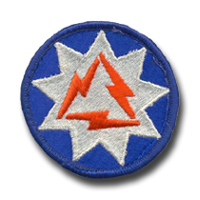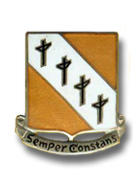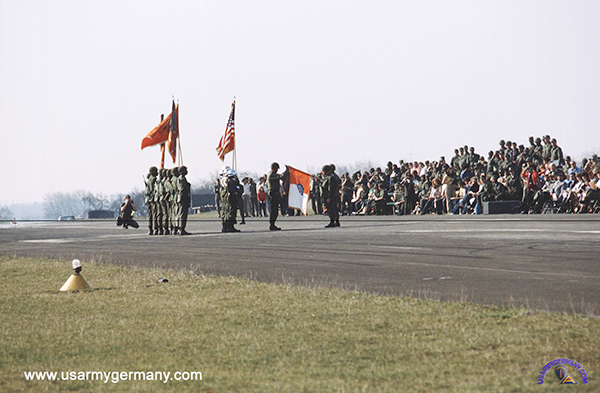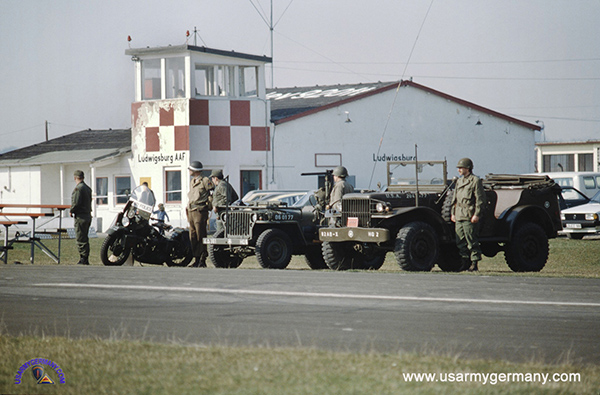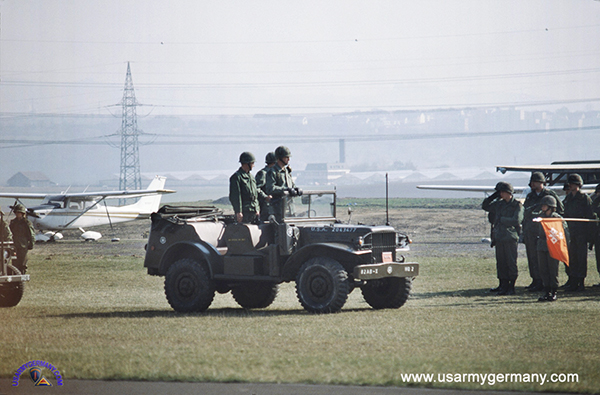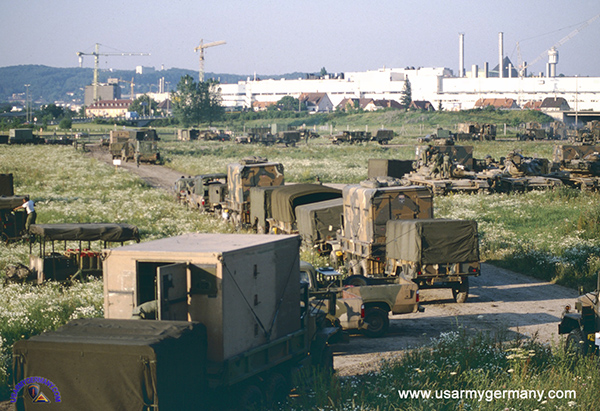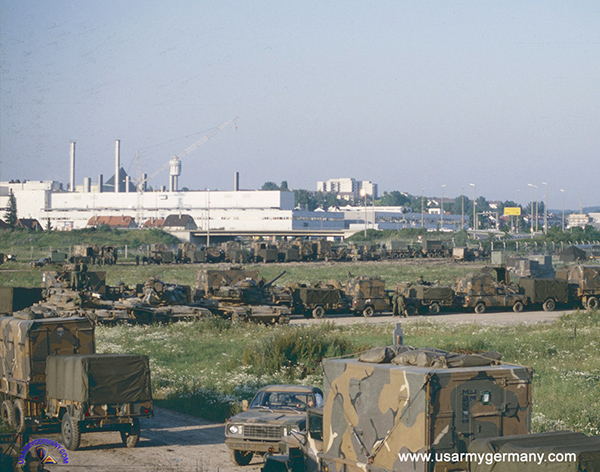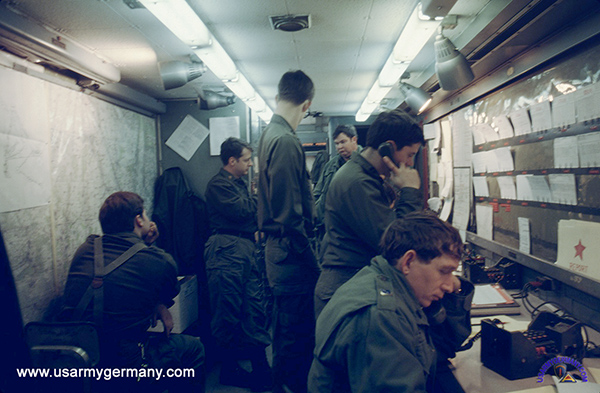| If you do
NOT see the Table of Contents frame to the left of this page, then
Click here to open 'USArmyGermany' frameset |
|||||
|
93rd
Signal Brigade |
|||||
|
|
|||||
|
|||||
|
|
|||||
| Brigade History | |||||
| 1980 - 1991 | |||||
| (Source: Brigade Unit History, PIO 93rd Signal Brigade, early 1980s) | |||||
|
The 93rd Signal Battalion was inactivated in September 1972 in Germany. On 2 January 1980, under the Echelons Above Division concept, the 93rd Sig Bn was reorganized and redesignated as Headquarters and Headquarters Company, 93rd Signal Brigade and the 93rd was formed as a provisional command at Kelley Barracks, Stuttgart. The VII Corps C-E Officer, Col David Partin, was designated its commander.
Because of lack of physical space to accommodate the entire headquarters, the Brigade Hqs was moved in June 1980 to Karls Kaserne, Ludwigsburg. On 20 February 1981, Col Billy Thomas assumed command. On 16 March 1981, the 93rd Sig Bde (Corps) was officially activated and established itself as the backbone of communications for VII Corps. The brigade supported VII Corps with three subordinate battalions: the 26th Signal Battalion (Corps Area) at Heilbronn, Germany, the 34th Signal Battalion (Corps Radio), and the 51st Signal Battalion (Command Operations), both located in Ludwigsburg. The 34th Sig Bn, located at Krabbenloch Kaserne, had already been a VII Corps units prior to the formation of the 93rd. On March 16 1980, the 34th (with four companies) was officially recognized as a part of the 93rd Sig Bde. The unit's mission was to provide Multichannel Radio and Radio Teletype communications to the Corps Message Centers. The 51st Sig Bn was formed at Nellingen and Krabbenloch Kasernes and joined the 93rd on 16 March 1981. The Battalion became the VII Corps Command Operation Signal Battalion with the mission of providing terminal communications facilities (message centers, data transmissions, air and motor message service, teletype) for Corps Headquarters, Corps Rear and the Corps TAC CP. The 26th Sig bn at Wharton Barracks, Heilbronn, joined VII Corps on April 16 1980. The mission of the 26th Sig Bn (four companies) was the installation of three Corps Area Signal Centers. These centers provided telephone and record communication which linked Corps Headquarters to the Division Field Artillery Brigades, higher headquarters and lateral corps headquarters. In 1990, the brigade deployed to Saudi Arabia with VII Corps in support of Operations Desert Shield and Desert Storm. During it's service in SW Asia the 93rd earned three more battle streamers: Defense of Saudi Arabia, Liberation and Defense of Kuwait, and Cease Fire. The three battalions were later inactivated in Germany and the 93rd Signal Brigade colors were returned to Fort Gordon for the brigade's official inactivation on 5 December 1991. The brigade was subsequently reactivated on 16 February 1998 at Fort Gordon . |
|||||
| (Source: Email from David Wolfer) | |||||
| First, a little about myself: I went into the Army in 1974. My first assignment was as a 72E with the 519th MPs at Ft Meade, MD; from there I went to the 414th Signal Company and then to the United States Communication Command Agency at Ft Meade. I was then sent to Germany to serve with the 34th Signal Bn as COMSEC officer, Top Secret Document Carrier NCOIC as well as the NCOIC of Repair and Utilty at the 34th. My next assignment was with Col Partin at VII Corps (more on that below) followed by an assignment with 2 Region USACIDC. That was followed by another tour with the 34th Signal Bn that I cannot talk about. Following that I was sent to Ft Gordon GA, 72E - FM and AR technical manual writer; Ft Gordon Rifle Team; and then NCOIC of the Wood Shop for Morale Support Unit at Ft Gordon. My final assignment was at Ft Leonard Wood, MO as a 51H. Formation of the 93rd Signal Brigade In January 1980, under the Echelons Above Division concept, the 93rd Signal Battalion was reorganized and redesignated as Headquarters and Headquarters Company, 93rd Signal Brigade. The 93rd was formed as a provisional command at Kelley Barracks, Stuttgart-Möhringen. The VII Corps C-E Officer, Col David Partin, was designated its commander. Kelley Barracks, where I wrote the War Plans as S2, did not have enough room to house the new Brigade. Sgt Betts and myself were asked by Col Partin to take control and build the Brigade at Karls Kaserne, Ludwigsburg. The building that was to be used for the 93rd Sig Bde HQ at Karls Kaserne was condemned and we did not have a budget - meaning we had to build everything from nothing. So Col Partin told the DOD that we would do it without spending any money. Betts and I then built the whole structure of the 93rd -- office equipment and vehicles and all that it took to make up the Brigade. Just about everything came from Property Disposal, even the vehicles. The building of the 93rd is a story all of its own. Betts and I worked non stop meaning our clothes were brought to us as well as our meals. When we could not go on another min, we would walk up to a wall sit on the floor and go to sleep. When we woke up, we would go right back to work. Non stop for days on end. Col Partin would visit us all the time, night and day. We begged, borrowed, traded and stole what we needed to build this Brigade. All the desks and office equipment were repaired by Betts and myself, and I repaired vehicles and motors, transmissions, etc to be used. Yes, WW2 parts and vehicles. So the first NCO Academy and arms room, communication center, everything was done by Betts and myself. The Karls Kaserne building itself was in complete ruins and the insides had to be rebuilt from the ground foor to the roof. Some examples of issues we faced - electrical wiring was from 1912; there were no bathrooms; there were holes in the ceilings of the rooms where you could see the sky. I had to rebuild all the motors for the 34th Signal and 93rd Bde lawn mowers. I did most of the work with my own tools. At the same time, I was also serving as the Repairs and Utility NCOIC for the 34th and the COMSEC officer, along with other duties. For our work I received the Army Commendation Medal and Betts and I received the first set of Brass from Gen Becton when the 93rd was activated in Ludwigsburg (March 1981). I also got a comment from Gen Becton because I stole his pile of sheet rock that was stored at Kelly Barracks to put into the buildings at Karls Kaserne. After Betts and I completed the building of the 93rd I went to the Secound Region USACIDC in Stuttgart. |
|||||
| If you have more
information on the history or organization of the 93rd Sig Bde, please
contact me |
|||||
| 93rd Sig Bde Units (1980s) | |||||
|
|||||
| 1981 | |||||
| (Source: Email from Steve Witt, 34th Sig Bn (1978-1981) and 93rd Sig Bde (1981-83)) | |||||
| Webmaser note: I have devided the contents of Steve's email into two sections - 34th Sig Bn and 93rd Sig Bde and posted them on their respective pages. Click here to read Part 1 on the 34th Sig Bn Page. 3. 93d Signal Bde (Corps) The 93d Signal Bde (Corps) was activated in January 1980. It was formed essentially by splitting the 34th Signal Bn (Corps) in half, all of its radio equipment formed a reorganized 34th Signal Bn (Radio) and all of the CommCen, telephone switching, and cable equipment formed the reactivated 51st Signal Bn (Command/Ops). An additional signal battalion, the 26th Signal Bn was transferred from 7th Signal Bde to the 93rd Signal Bde minus its D Company, which remained in 7th Signal Bde. The 34th and 51st Signal Bns remained at Krabbenloch Kaserne in Ludwigsburg. The 26th Signal Bn remained at Wharton Barracks in Heilbronn, FRG. The new 93d Signal Bde HHC was located at Ludendorff Kaserne in Kornwestheim, FRG. We were told that the reason the new brigade was called the 93d was that the 93d Signal Bn was the last signal unit to be deactivated and so its designation and insignia would be used for the next signal unit to be activated. Another related factor was that the VII Corps Signal Officer at the time of the 93d's activation was COL David W. Parton. I believe that COL Parton was the battalion commander of the 93d Signal Bn when it was deactivated in the early 1970s. I imagine that COL Parton was influential in assigning the 93d designation to the new brigade but that is speculation on my part. COL Parton became the first commander of the 93d Signal Bde. The corps signal brigade commanders were 'dual-hatted' and were both the corps signal officer and signal brigade commander. The formation of the 93d Signal Bde was not easy and caused a lot of turmoil. It took a few months after the activation of the 93d for the reorganization of the new 34th and 51st Signal Bns to be completed. There were a lot of problems due in large part to the fact that the 93d was formed before its modified table of organization and equipment (MTOE) was active which meant that each company could not order vehicle and electronic equipment parts for maintenance and the battalions could not requisition personnel. It took about a year for this to be worked out and for everyone to get used to the new organization. In August 1980 the 93d had its first communications training exercise with the new Brigade organization. This was Operation Orange Harmony and was held in a big unused open area at Panzer Kaserne in Boeblingen, FRG. This was a dry-run for the upcoming REFORGER field training exercise (FTX) in September 1980. During this first year the 93d still installed communications in a 'command' system similarly to the the old 34th Signal Bn (Corps). The 26th Signal Bn, though now part of the 93d, still installed its area communication system as it had when it was part of the 7th Signal Bde. In February 1981, COL Billy M. Thomas (later LTG) took command of the 93d Signal Bde. In June 1981, LTG William J. Livsey took command of VII Corps. LTG Livsey took a lot of interest in signal operations in the Corps and directed that the 93d be required to provide communications committing only about 70% of its equipment and that the rest be held in reserve. This inevitably meant that some Corps units that had previously received communications support from the Corps signal brigade would now not receive this support. Only the maneuver and fire support MSCs would be supported by the 93d and the logistics units were not. LTG Livsey's desire was that the signal brigade would always be capable of providing communications support to the higher priority MSCs and the lower priority MSCs would have to find a different means of communications support as part of their field operations and use that mechanism during their exercises. |
|||||
As part of taking this fresh look at providing signal support to the Corps, the 93d S-3 staff developed a new communications scheme. The command system scheme that the old 34th Signal Bn (Corps) had installed had always proved very unwieldy. The very large signal center at Corps Main that was necessary for the command system made jumping Corps Main very difficult and was, in fact, never done (in my time there) until LTG Livsey took command of the Corps. The 93d scrapped the command system completely and and developed an area communications system in which several smaller signal centers were installed by the 93d and the Corps CPs and MSC CPs were provided multichannel radio systems from these area signal centers. This area system greatly improved communications within the Corps, it reduced the huge concentration of signal equipment at Corps Main allowing that CP to jump much more easily and also led to much better dispersion of Corps signal assets reducing the ability of the enemy to destroy our command and control. The Corps units that were not receiving communications support from the 93d were now provided communications by leasing civilian telephone lines from the Deutsche Bundespost (DBP). Another innovation that improved communications service was that commercial fax machines were leased and placed in many of the staff sections of the Corps and MSC CPs and were connected to both the DBP telephones and the 93d's military telephones. This greatly reduced the requirement for all record traffic to be sent using the 93d Signal Bde's CommCen teletype circuits freeing them up for higher priority traffic. The ability of the 93d Signal Brigade to provide effective communications steadily improved in late 1981 and 1982. In September 1982 USAREUR conducted another REFORGER FTX that was, we were told, one of the largest FTXs that had been conducted in recent memory. In REFORGER 82 VII Corps was the Blue force and for the first time since I had been in Europe, the 93d Signal Bde was also part of the Blue Forces meaning that the Brigade's signal sites could be attacked like any of the Blue or Red forces. This had never been allowed before as the Corps staff was unwilling to accept the possibility of major disruptions of the Corps communications system, as unrealistic as that might be. During the exercise, the 93d's CP was attacked during the night by a platoon-sized element from the 82d Airborne Div, which was a Red Force unit operating behind the Blue Force lines. We repulsed their attack -- yeah we were all just firing blanks, but we all thought it was pretty cool. REFORGER 82 was a very successful FTX for the 93d and this proved that the brigade had finally become a very effective unit. |
|||||
|
|
|||||
| Related Links: 93rd Signal Brigade - official website of the active unit at Fort Gordon, Georgia |
|||||
